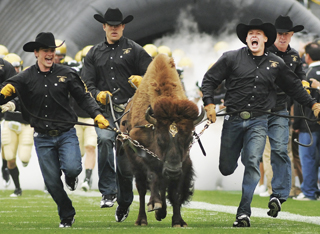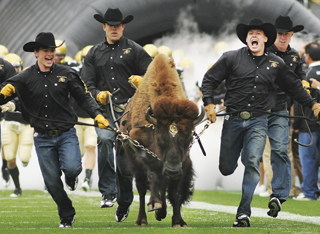

Back in Boulder
Kyle Ringo //December 1, 2014//
 Not many successful CEO types would jump at the chance to lead an organization failing as badly as the University of Colorado’s athletic department was just one year ago. Fixing a department drowning in debt, hemorrhaging customers, with apathy among donors and competitors relishing every chance to rub the Buffaloes’ noses in it, hardly seemed like a dream job.
Not many successful CEO types would jump at the chance to lead an organization failing as badly as the University of Colorado’s athletic department was just one year ago. Fixing a department drowning in debt, hemorrhaging customers, with apathy among donors and competitors relishing every chance to rub the Buffaloes’ noses in it, hardly seemed like a dream job.
Yet Rick George left behind a lucrative vice president position with the Texas Rangers of Major League Baseball to dive into a restoration project in Boulder few thought could be accomplished. He is the sixth full-time athletic director in the school’s history. While the final results are still in the distance, George is off to a strong start with record-breaking fundraising totals enabling the start of a major overhaul of portions of Folsom Field and the surrounding area that will require an estimated $181 million.
CU athletics had never raised more than $15 million in private donations in a single year before George arrived. The program collected nearly $50 million his first year as athletic director.
“I know we need to think big and we need to go big,” he said in his first days on the job. “We just need to have a very good game plan.”
George inherited a $5.6 million budget shortfall caused by poor football ticket sales adding to more than $20 million the department already owed the school because of the costs of switching conferences in 2011 and multiple football coaching changes. He managed to trim the shortfall to $4 million by cutting expenses during his first year, and he submitted a balanced budget for the 2014-15 school year, the first balanced budget submitted by the department since CU made the move to the Pac-12 Conference.
George also brought together more than 30 people, some in his department and some from the outside, to create a strategic plan for CU athletics. It set goals for each program and the department as a whole for the next three years, including its long-struggling football team playing in the conference championship game by 2016.
“I feel like we’ve done a lot, but there is just so much to do moving forward for us. We’ve got to stabilize our financial situation,” George said. “We’ve got to find ways to generate revenue, and we’ve still got a lot of work to do on that.”
George, 54, always has been driven and a guy people are drawn to. He earned a scholarship to play football as a defensive back at the University of Illinois in the 1980s. When he graduated with a degree in sports communication and journalism, his coach, Mike White, named him assistant director for player personnel, and a year later he was leading the recruiting efforts for the football program and the rest of the athletic department.
Shortly after earning his degree, George reached out to Frank Beaudine, a man about as well-connected in the world of college sports as anyone at the time. Beaudine was one of the first headhunters to assist schools in searches for head coaches and athletic directors.
George said he knew he wanted to build a career in college sports and figured he needed to make sure Beaudine knew who he was. So he called Beaudine, who agreed to meet the bold young man on the other end of the line during one of Beaudine’s trips when he had a short layover in a Chicago airport.
That meeting eventually helped George find an opportunity at Colorado in 1987 working under former CU football coach Bill McCartney as recruiting coordinator. He helped recruit much of the 1990 national championship team.
George left the school in 1991 to become an assistant athletic director at Vanderbilt, but he says he always dreamed of returning to CU one day. He and his wife, Nancy, have regularly vacationed in the state for years and often talked about buying a home here where they could retire.
After leading a children’s charity, the PGA Tour and helping the Rangers uplift their corporate sponsorships from $18 million to more than $40 million in less than three years, George was ready when the CU athletic director job came open in May 2013. It felt like kismet, he said.
“Rick is high energy. Rick is a positive, can-do kind of guy,” said Jim Senter, former CU senior associate athletic director and now athletic director at The Citadel in South Carolina. “My sense is if you’re working with Rick, for Rick, you better have those same kind of attributes: Let’s go get it done. Let’s work hard, have a good time and have fun doing it. And let’s measure what we’re doing.”
George took over not just during an exciting time for the Colorado department in terms of the challenges of building new facilities, but also at a fascinating time in college sports. As a member of the Pac-12 Conference, CU is one of 65 schools in five power conferences that have recently been given autonomy by the NCAA to live under a new set of rules geared toward being able to provide more for student-athletes.
“I love his approach,” Pac-12 Conference commissioner Larry Scott said in July after getting to know George during the past year. “I think he comes with a very unique vantage point and a very positive one. He’s got a real genuine passion and connection with Colorado, given his roots. His experience in a variety of professional sports and dealing in the worlds of media marketing I think is a really good fit for Colorado, especially at this point in time when there needs to be a transformative agenda with some bold and progressive thinking to be competitive with the other Pac-12 schools. I think he brings a great skill set.”
The critical importance of fundraising in college sports was underscored up the road at Colorado State University, where efforts to raise money for an on-campus football stadium have lagged, and Athletic Director Jack Graham was fired in August.
George is focused on creating new revenue streams for CU sports. He opened two beer gardens in the football stadium this fall as an experiment to see how popular they would be with fans and how it might help the bottom line. He signed a 10-year deal with a new concessionaire. He hopes to open space in the south end of Folsom Field to lease to private businesses in the next year. CU is partnering with Boulder Community Health on its high performance sports center that will also be the new home for BCH’s Boulder Center for Sports Medicine operations.
Such partnerships never had been considered before George arrived. His experience developing corporate partnerships at the PGA and with the Rangers has opened new doors for CU’s efforts to catch up to the rest of the Pac-12. Cory Hilliard, associate athletic director for business operations, said George has challenged him to look at every partnership, agreement and contract the athletic department has and see how CU can do better from a national perspective.
George said the department he took over in August 2013 ranked near the bottom of the 65 schools in the power five conferences in private donations and revenue generation. He said before he leaves his job he’s determined to move the Buffs into the upper-echelon of those rankings.
“We want to be a significant player in this five-conference, 65-school autonomous group,” George said. “So we’re going to have to step it up.”


























